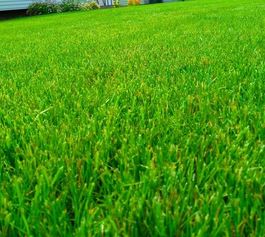 Since autumn is just around the corner, that means your lawn’s growing season is just around the corner as well. You may have noticed your grass slows down during the summer months—it doesn’t grow as fast, which means less mowing, and it often takes on a brownish hue, some might even call it “crispy.” This, of course, is completely normal for Michigan lawns. The hot summer months are the dormant period for cool-weather grasses. But as the daytime temps dip into the 70s more regularly, and precipitation picks up, you can expect your lawn to start “growing and greening” again. With that, there are some things you can do to make your lawn healthier and thicker. 1. Fall is a great time to fertilize. Good Sweet Earth applies organic fertilizer (an alfalfa blend fertilizer) twice a year: in spring and fall. If you were going to only apply fertilizer one time a year, I recommend fall over spring. Why? A few reasons: First, fall fertilization gives your lawn some nutrients before the long, harsh winter. This will make it less distressed when spring rolls around. It also adds organic matter to your soil to help insulate the roots a bit. Second, if you’re applying slow-release organic fertilizer, it won’t break down entirely before winter sets in, which means there will likely be some semi-composted product still on your lawn in the spring; it’s sort of an early spring meal for your lawn which will help green it up early and get it growing strong. Finally, there are less weeds germinating in the fall, which means the nutrients you put in your soil will be more available for your grass, instead of those nasty invasive plants you’d rather not be fertilizing. If you're interested in having us apply some alfalfa blend fertilizer to your lawn, get in touch. 2. Fall is the ideal time to overseed. Like fertilizing, you can overseed in either spring or fall. I prefer late summer/early fall because your grass seeds won’t be competing for space with weed seeds as much. Those gaps in your lawn where grass isn’t growing are prime real estate for weeds. But as your soil gets healthier from organic lawn treatments, those gaps will fill in with grass—unless weeds get there first! In the fall, there are less weed seeds looking for a home, so putting grass seed down in late-August or earl-September (you could do it as late as the first part of October, especially if we have a warm fall) will ensure the grass has a head start over the weeds come spring. To overseed, first, mow your grass lower than you normally would; if the clippings are especially long or clumpy, rake them up so the seed can fall easily to the soil below. Second, buy a sun/shade mix and apply it with a spreader or scatter it evenly by hand. The rate you should be applying is typically 4-6 pounds per 1000 square feet (a 10,000 square foot turf space should be overseeded with about 50 pounds). For bare spots in your lawn: Mix the seed with a little potting soil (soil + compost) and apply it directly as a patch. If rain’s not in the forecast, water it regularly. Every year you do this will mean thicker and less weedy turf. 3. If you’re going to aerate your lawn, do it in fall. Summer is a bad time for aeration simply because you don’t want to distress your lawn any more than you have to during its dormancy. In fall, the grass is growing strong and can recover better from the aeration process. If you’re going to aerate, either hire a company to do core aeration (pulling plugs of soil out of the ground), or rent a core aeration machine and do it yourself. Do NOT succumb to the idea of putting spikes on your shoes and walking around your yard. That simply compacts the soil further. To properly aerate, you need to pull plugs out of the ground so that water and air can get in. Poking holes with spikes won’t do that. That being said, aeration is typically only necessary once every few years, and usually only with over-chemicaled yards. When soil is healthy, full of microbes, worms, bugs and organic matter, it doesn’t need core aeration—the worms and bugs and microbes aerate it for you.
0 Comments
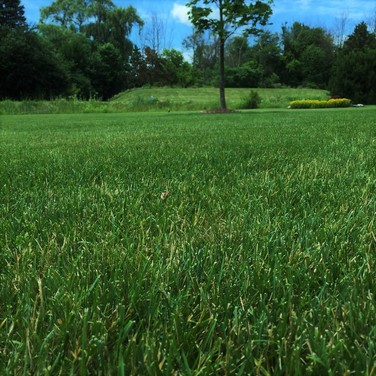 A couple weeks ago, I taught a class at Meijer Gardens in Grand Rapids on eco-friendly lawns. I have to say, preparing to teach a class on your life’s work really helps you organize your thoughts and mission. I came out of this experience with a clearer understanding of, not just how I approach organic lawn care, but why I do it the way I do. I’ve always thought of myself as a “lawn guy.” I’m certified in lawn care management through the University of Georgia, I’ve joined the National Association of Landcare Professionals (NALP), and I help people get their turf strong and healthy. That would fit most people’s definitions of “lawn guy.” But after doing this class at Meijer Gardens, I realized I’m not so much a “lawn guy” as I am a “soil guy.” But the two aren’t mutually exclusive. If you’re a lawn guy without also being a soil guy, you’re potentially doing long-term damage to the turf (not to mention the planet). If a lawn guy is simply interested in getting your lawn green and weed-free in a matter of days, with no concern for the health and fertility of the soil below, your lawn’s going to suffer. Applying synthetic chemical fertilizers and herbicides kill the soil, plain and simple. But as a lawn guy, who’s also primarily a soil guy, I’m more interested in creating healthy soil—full of microbes, worms, beetles, organic material, nutrients that don’t leach away—than I am in making your lawn instantly green and weed-free. Healthy soil will give you healthy turf. Dead soil will give you, well, dead turf. Now don’t get me wrong, I’m still interested in giving people a lawn that’s green and relatively “weed free,” but there’s no magic instantaneous potion that can do that while NOT killing the soil, and don’t let anyone tell you otherwise. And that’s why I am so passionate about feeding the soil, rather than the grass. That’s how nature’s been doing it for millennia. Soil damaged by synthetic chemicals will ultimately give you weak turf and “dead zones” where weeds pop up and grass just doesn’t grow… and then the chemical lawn guys will tell you how much you need them to get your lawn looking good again. And it’s true, in a twisted way—through chemicals, they’ve created a lawn that is wholly dependent upon more environmentally-damaging chemicals for its survival. But what your lawn really needs is healthy soil. Healthy soil will give you healthier, stronger turf. Healthier, stronger turf will push out those pesky plants we know as weeds. And that’s why my focus is to give our customers healthy soil—by feeding your soil with microbes, compost, natural fertilizers like alfalfa and kelp. So when I work on a lawn, I’m doing it as a “soil guy” first and foremost. And when you take care of the soil, your lawn is actually sustainable and healthy, not dependent and weak. If you'd like to have Good Sweet Earth give you a healthier lawn by improving your soil, get in touch with me at [email protected] or call us at 616-594-0693. 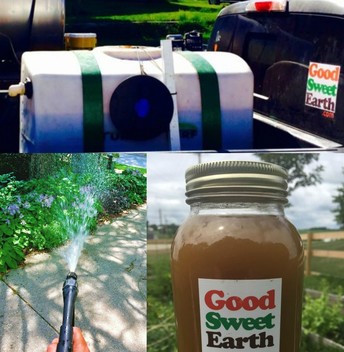 If you’re familiar with compost tea, our Worm Tea is similar, except instead of using traditional hot compost (or thermophilic compost), we use our own Living Worm Compost. Our Worm Tea is sold by the gallon to backyard gardeners for flowers, fruits, veggies, shrubbery and as a compost pile activator. It’s also used by farmers on their crops as a microbial drench and anti-fungal agent. Finally, we use it on lawns. Before we get into how we make our Worm Tea, let’s look at different types of microbial tea and the different methods of making it. Then we can get into how we do it, and why we do it that way. The basic recipe of compost tea consists of compost (the source of the beneficial microbes), a food source for the microbes (typically molasses) and water (distilled, rain or well water; using municipal water straight from the tap can kill the microbes because of added chemicals like chlorine). Other things can be added to give the finished product a more complex microbial population or nutrients. But those are the basics. For a simple recipe, just throw a pound or two of compost into the bottom of a five-gallon bucket, add a half cup of black strap molasses and fill the bucket with distilled water. Let it sit in the sun for a few days, and you’ll begin seeing some film, froth and bubbles. This is evidence of your microbial population growing. You could simply add this to your plants and soil. The problem with this method is it’s a little haphazard. First, it’s anaerobic, meaning there’s no added oxygen, so you can often end up with dangerous microbes. Second, traditional hot compost isn’t very uniform. It might not be completely “finished” (meaning it might contain pathogens or materials that aren’t necessarily beneficial), it could be too “finished” (meaning it lacks any sort of nutrients), and since different materials break down differently, every batch of hot compost is completely different from the next. To create a safer compost tea, you could consider adding oxygen by way of an aquarium or pond aerator. Simply use the ingredients from above, but then plunk some aeration stones attached to an aerator and let it bubble for a couple days. This will give you an aerobic (active in the presence of oxygen) tea. The problem you might face now is a product that doesn’t come out of a spray bottle cleanly. With your compost simply tossed into the bucket, you’re going to have chunks and slurry in the finished product. To fix this, use an old pair of panty hose. Or a burlap sack. So now comes the question: What’s the difference between tea made with traditional hot compost and tea made with vermicompost (like our Living Worm Compost)? Difference #1: Vermicompost is completely “finished.” You never have to worry about semi-composted chunks of matter (sometimes containing pathogens) getting into your tea. When a worm eats the organic material and poops it out, it’s done. It gives you a more uniform result because vermicompost itself is more uniform than hot compost. Difference #2: Unlike traditional hot compost, which often has all the nutrients leach out or get destroyed by the high temperatures, vermicompost still contains trace amounts of nutrients. That’s good for your plants. At the end of the day, tea—whether it’s made from hot compost or vermicompost—is meant to give your soil and plants a boost of microbes. Those microbes, both fungi and bacteria, help break down organic matter in your soil and serve as an anti-fungal agent. Without life in your soil, your plants will suffer. So now on to how we make our Good Sweet Earth Worm Tea: We use specially-made compost tea bags that we fill with our Living Worm Compost. We also add a special blend of alfalfa meal and kelp for added growth hormones and iron, respectively. To that we will add black-strap molasses. We add the water from our underground aquafer (fancy way of saying “our well”) and turn on the large pond bubbler. The whole thing is done inside our 100-gallon tank, which we can use to apply it directly to lawns, transfer into a farmer’s irrigation tank, or put into jugs and buckets for individual use. We let the tea brew for between 24 and 72 hours (earlier in the season, when temps are still cool, it takes longer to get the microbe population up to where it needs to be; in mid- to late-summer, the microbes multiply faster in the heat). Now when it comes to brewing our Worm Tea for use on lawns, we’ll at times add other ingredients based on the needs of a customer’s turf at any given time. Sometimes we’ll add more kelp extract, sometimes we’ll add another bit of alfalfa. If we want more a more fungal tea (not typical for lawns), we can add oats or spent distillers grains. If we want a more bacterial tea (good for lawns), fish emulsion or additional sugars (maple syrup, cane sugar, etc) can be added. For the tea that we sell at farmers markets and on our website, our recipe is pretty standard: Living Worm Compost, aquafer/rain water, kelp, molasses, alfalfa meal. This is the recipe that we’ve found gives the best results, and it keeps things consistent for everyone that uses it. And there it is. It sounds relatively simple, and at its core, it is. However, what we’ve been working on over the past several years is ingredient ratios, brew time and oxygen levels. And that’s where we feel like we’ve hit the sweet spot. If you’re interested in purchasing our tea (available only in West Michigan), check out our product page. Be aware: Since it does contain living organisms, you will need to use it within 8 hours of getting it. 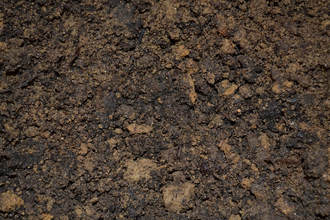 At Good Sweet Earth, we believe healthy soil is the key to a healthier—well, everything. It’s the key to producing healthier food, keeping our watersheds clean, giving us more breathable air, and even reducing the greenhouse gasses responsible for climate change. Reducing the amount of chemicals in the soil around our homes exposes us to less carcinogens, which is healthier for our families. Healthy soil provides a home to billions and billions of lifeforms, which are threatened when soil is tainted with chemical fertilizers and herbicides. And when soil is healthy, it helps prevent erosion. Soil is life. But what exactly does soil do? According to the Soil Science of America, they describe the basics of soil like this: Soil is an amazing substance. A complex mix of minerals, air, water, and countless microorganisms, soil forms at the surface of land and comes in many types. Put another way, soil is the thin, outermost layer of Earth’s crust, and like our own skin, we can’t live without soil. Why?
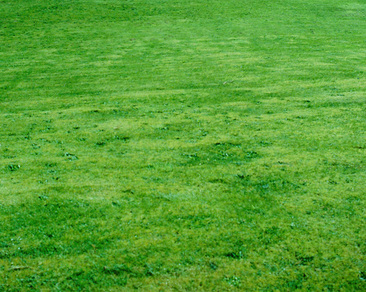 Our lawns are about as unnatural an ecosystem as you're ever going to find. And by "unnatural," I mean you're just not going to find anything similar anywhere in nature. Tell me where you're going to find several thousand square feet of Kentucky Bluegrass, neatly contained with sharp edges, kept at a length of 2-3 inches at all times, with no other vegetation allowed to penetrate the borders. Short answer: No where! Not in the woods, not in the rain forest, not in the desert, not in the tropics, not even on the prairie. Oh sure, there are pastures, where animals graze on grass, but there's nothing quite like a lawn anywhere outside our yards. It's entirely a man-made construct. Lawns as we know them-- closely-cut areas of grass-- first emerged in 17th century England, where they were a status symbol of the aristrocracy. The nobility could show off that they could afford land that contained neither buildings nor food. The lawn was born as a recreational area, which is what remains today. Sort of a shag carpeting for outdoor living. But no matter how you slice it, it ain't natural. Now don't get me wrong, I enjoy having a lush green lawn as much as the next All-American homeowner, but the standards we have set for our lawns have become nearly unsustainable. Anything less than a uniform blanket of perfectly green grass blades is seen as an ugly failure. And that's why we've become so reliant on chemicals. If it's not brilliantly green from April until November? Failure. If clover appears? Failure. If success isn't instant? Failure. But those chemical fertilizers, are actually killing your yard's plant life because those chemicals are killing the microorganisms and fungi and bugs in your soil. Those critters are vital to a healthy ecosystem. Our planet thrived because of those critters long before chemical fertilizers arrived on the scene. Not putting those chemicals on your lawn this year would be the first step toward restoring life to your soil. But here's the thing: Just stopping the chemicals won't necessarily give you society's version of a perfect lawn. Why? Because lawns require a lot of nutrients, and they take a lot of abuse from foot traffic and pets and mother nature (winters, droughts, etc). Those nasty chemical fertilizers are one option to give your lawn the nutrients it needs, but as I said, the chemicals actually do more damage than good. They weaken the roots, they compact the soil, they cause thatch, they cause your lawn to become chemically dependent, they pollute the environment and can make you and your pets sick. So while getting rid of the chemicals will slowly allow those vital microorganisms to return to your soil, there probably will never be enough of them naturally-occurring in your soil to give you that "wow" lawn. So what do we do at Good Sweet Earth to make our lawn look great, without adding chemicals to it? We apply Worm Tea as an organic microbial soil drench-- Worm Tea has billions of those beneficial microorganisms and fungi living and breathing in one teaspoonful. Imagine what regularly applying Worm Tea to your yard could do for your soil! It could increase the amount of those wonderful microorganisms a thousandfold, or more, in just one season of regular applications! And why is that important? Because those microorganisms break down organic matter in lawn-- clippings, leaves, worm castings, compost-- and release nutrients into your soil for your lawn to soak up. Worm Tea is like delivering billions of nutrient factories straight to your lawn. So to reiterate: those microorganisms will always exist in a chemical-free lawn, but there probably won't ever be enough to sustain a truly healthy lawn all year. To get that healthy lawn, you need healthy soil, and to get soil healthy and nutrient-rich enough to sustain a beautiful lawn, you need to infuse it with more microorganisms! Worm Tea does it. Contact us if you're interested in infusing your soil with billions of those wonderful nutrient factories this year, or read more about what it can do for your lawn. |
